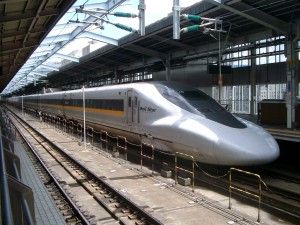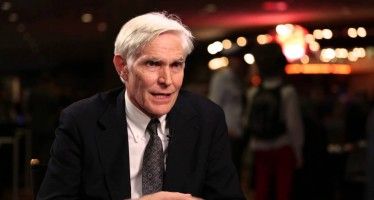CA bullet train crashes through federal, state safeguards
Jan. 28, 2013
By Chris Reed
 Reports that the California High-Speed Rail Authority and Amtrak are teaming up to buy bullet trains and that the state is preparing for hundreds of eminent-domain property seizures in the Central Valley for the bullet train’s first segment are grim reminders that common sense and fiscal responsibility are under siege in Sacramento and Washington.
Reports that the California High-Speed Rail Authority and Amtrak are teaming up to buy bullet trains and that the state is preparing for hundreds of eminent-domain property seizures in the Central Valley for the bullet train’s first segment are grim reminders that common sense and fiscal responsibility are under siege in Sacramento and Washington.
But however one feels about the $68 billion bullet train project, its 50-month journey from the California ballot box to the present day should give pause to those who believe in the law, due process and democracy. Both a plainly written state law and crystal-clear federal regulations were supposed to protect taxpayers from the project proceeding if there were warning bells about its viability and prudence. In California, the warning bells haven’t been occasional; they’re so constant as to be deafening. Yet the project keeps moving along.
In November 2008, California voters narrowly approved Proposition 1A, providing $9.95 billion in state bond seed money for a statewide high-speed rail system. Virtually all the promises that were made to win over reluctant voters have proven to be gross exaggerations — whether on cost, ridership, job creation or the likelihood of substantial private investment. But deceptive ballot campaigns for state propositions are legal.
A business plan built around an illegality
However, the state law that was enacted with the passage of 1A is a binding document on the government of California — at least in theory. But the latest version of the rail authority’s business plan, released last May, showed a project on path to run afoul of state law in essential ways.
The business plan continues to assert that there is a likelihood of substantial private investment. But such investment can only be attracted with ridership or revenue guarantees that Legislative Analyst Mac Taylor and others say violate Proposition 1A’s guarantee that there will be no taxpayer subsidies of operating costs. If the guarantees aren’t met, taxpayers have to make up the difference to investors.
Then there is the basic issue of speed. Under the unusually specific language of Proposition 1A, the bullet train is supposed to connect San Francisco with Union Station in Los Angeles, about 382 miles, in a “maximum express service travel time” of two hour and 42 minutes — averaging a minimum of 141 mph. But in order to shave $30 billion off the project’s cost, the Brown administration gave up on bringing true high-speed rail to Los Angeles and its northern suburbs and to Silicon Valley and the peninsula south of San Francisco. The “blended approach” planners now recommend calls for linking the southern end of Silicon Valley with the northern exurbs of Los Angeles with a high-speed rail route that is integrated at each “bookend” with existing rail.
 But if the first 50 miles and the last 50 miles of the route are in heavily populated areas where speeds must drastically slow, getting from Union Station to San Francisco in the mandatory 162 minutes or less looks impossible. Perhaps this is why the 212-page business plan is mum on the topic — even though a memo distributed to the rail authority board last year anticipated a three-hour trip, the same estimate that was used in legislative debates last summer before final approval was given to spend $8 billion of state and federal funds to begin building the first segment of 130 miles in the Central Valley.
But if the first 50 miles and the last 50 miles of the route are in heavily populated areas where speeds must drastically slow, getting from Union Station to San Francisco in the mandatory 162 minutes or less looks impossible. Perhaps this is why the 212-page business plan is mum on the topic — even though a memo distributed to the rail authority board last year anticipated a three-hour trip, the same estimate that was used in legislative debates last summer before final approval was given to spend $8 billion of state and federal funds to begin building the first segment of 130 miles in the Central Valley.
Once again, the language in Proposition 1A forbidding operating subsidies and mandating minimum train speed aren’t guidelines or goals. They are the law of the state of California.
The ‘betrayal of Californians’ is at hand
In a 2011 interview I did with Howard Jarvis Taxpayers Association President Jon Coupal on KOGO 600 AM, we discussed the protections that taxpayers appeared to have from the boondoggle proceeding. Coupal told me that if Gov. Jerry Brown and the Legislature ignored the safeguards written into Proposition 1A, it would be a “betrayal of Californians.” The betrayal is at hand, Coupal noted last week in an email exchange.
But it’s not just Californians being betrayed by the bullet train project. It is all U.S. taxpayers. Federal regulations governing the spending of the $787 billion 2009 stimulus have the force of law. When it comes to the $3.5 billion in federal funding to be used for the Central Valley high-speed rail segment, these rules are simply being ignored.
The specific rules on the use of stimulus funds for state high-speed rail projects were published in the Federal Register on June 23, 2009. They said states could only receive stimulus funds if “rigorous analysis” showed their proposals had a sound “financial plan (capital and operating)” that reflected well upon the “quality of planning process” and had financial estimates reflecting “reasonableness.”
So much for “rigorous analysis.” The present bullet train’s financial plan depends on private investment that will never be forthcoming and upon tens of billions of dollars in new federal funding in the exact category — discretionary domestic spending — that is likely to wither as Washington acts to reduce trillion-dollar deficits. Its planning process has been chaotic; the decision to build the first link in the Central Valley was imposed on the state rail authority by the Obama administration only after years of planning that anticipated initial work in the state’s most populated areas. And “reasonableness” is not a word that will be associated with the project’s financing, given that it is based on assumptions of private investment that will never be forthcoming — at least without illegal promises of taxpayer subsidies if ridership or revenue is less than projected. This broad skepticism isn’t just from California small-government ideologues. It is shared by, among many others, the editorial page of The Washington Post.
‘Federal standards aren’t being met’
“None of the federal standards are being met,” state Sen. Mark Wyland, R-Encinitas, told me in an email. “If improving transportation for Californians is the goal, then we are idling on the wrong track. The federal government needs to realize that this plan is a money pit.”
Unfortunately, the highest-profile legal challenge to the project seen so far has struggled to gain traction. Three lawsuits are being heard in a single trial in Sacramento Superior Court. They allege the project’s environmental impact report didn’t meet California Environmental Quality Act standards and had key details approved in a manner that violated open-meeting laws.
But what’s needed is a lawsuit that is much more basic and builds on the original wording of Proposition 1A. The bullet train has to have a legal business plan, and it has to get from Union Station in L.A. to San Francisco in two hours and 42 minutes or less. If it can’t meet these conditions, that should matter to judges and juries who believe we are nation of laws, not men.
Related Articles
VIDEO: The Cure in The Code: How Technology is Transforming Medicine
Revolutionary advancements in technology are transforming medicine. Manhattan Institute author Peter H. Huber joins Brian Calle to talk about how
Take your pooch out to eat
Gov. Jerry Brown just signed a bill legalizing restaurants and bars allowing pets on patios, starting Jan. 1. Given all the
CARB tightens regs, partners with cops
Oct. 19, 2012 By Katy Grimes SACRAMENTO — The monthly meeting of the California Air Resources Board on Thursday was




